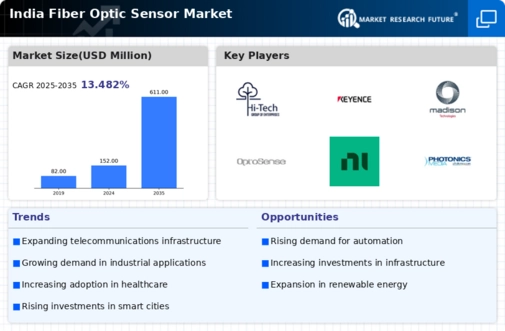Advancements in Industrial Automation
The fiber optic-sensor market is significantly influenced by advancements in industrial automation within India. As industries increasingly adopt automation technologies, the demand for precise and reliable sensing solutions rises. Fiber optic sensors offer advantages such as immunity to electromagnetic interference and high sensitivity, making them suitable for various industrial applications. The Indian manufacturing sector is expected to grow at a CAGR of 10% over the next five years, driven by the adoption of Industry 4.0 practices. This growth is likely to enhance the demand for fiber optic sensors, as they are integral to automated systems for monitoring and control. The integration of these sensors into industrial processes could lead to improved efficiency and reduced operational costs.
Growing Focus on Renewable Energy Sources
The fiber optic-sensor market is poised for growth due to the increasing focus on renewable energy sources in India. As the country aims to achieve 175 GW of renewable energy capacity by 2022, the need for efficient monitoring and management systems becomes critical. Fiber optic sensors are utilized in solar and wind energy applications for performance monitoring and fault detection. Their ability to withstand harsh environmental conditions makes them ideal for deployment in renewable energy projects. The market for fiber optic sensors in this sector is projected to grow by 20% annually, reflecting the rising investments in clean energy initiatives. This trend indicates a promising future for the fiber optic-sensor market as it aligns with national energy goals.
Rising Demand for High-Speed Communication
The fiber optic-sensor market is experiencing a surge in demand driven by the increasing need for high-speed communication networks in India. As the country progresses towards digitalization, the requirement for faster data transmission is paramount. Fiber optic sensors, known for their ability to transmit data over long distances with minimal loss, are becoming essential in telecommunications. The Indian government has set ambitious targets for broadband penetration, aiming for 50% coverage by 2025. This initiative is likely to propel the fiber optic-sensor market, as these sensors are integral to the infrastructure needed for high-speed internet. Furthermore, the market is projected to grow at a CAGR of 15% over the next five years, indicating a robust expansion fueled by this demand.
Increased Investment in Smart Infrastructure
The fiber optic-sensor market is benefiting from the heightened investment in smart infrastructure across India. Urbanization and the push for smart cities have led to the integration of advanced technologies in urban planning. Fiber optic sensors play a crucial role in monitoring structural health, environmental conditions, and energy consumption in smart buildings. The Indian government has allocated substantial funds for smart city projects, with an estimated budget of $1.5 billion for the current fiscal year. This investment is expected to enhance the adoption of fiber optic sensors, as they provide real-time data and improve operational efficiency. Consequently, the market is likely to see a significant uptick in demand as cities evolve into smart ecosystems.
Enhanced Safety Regulations in Critical Industries
The fiber optic-sensor market is being propelled by enhanced safety regulations in critical industries such as oil and gas, mining, and transportation in India. Stringent safety standards necessitate the implementation of advanced monitoring systems to detect hazards and ensure compliance. Fiber optic sensors are increasingly utilized for their ability to provide real-time data on temperature, pressure, and strain, which are vital for maintaining safety in hazardous environments. The Indian government has introduced regulations mandating the use of advanced monitoring technologies in these sectors, which is likely to drive the adoption of fiber optic sensors. As industries strive to meet these regulations, the market is expected to witness substantial growth, reflecting the importance of safety in operational practices.

















Leave a Comment